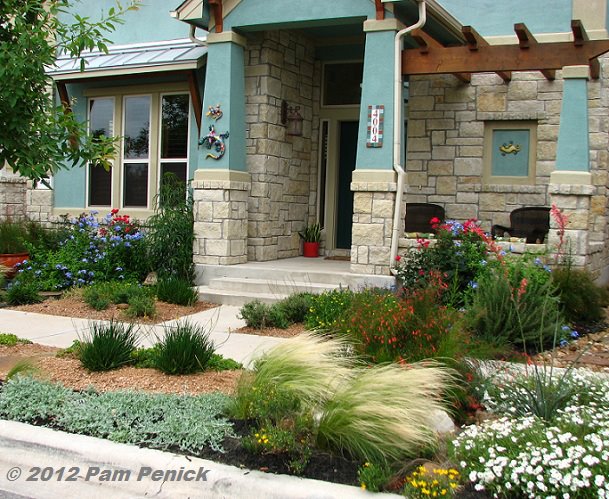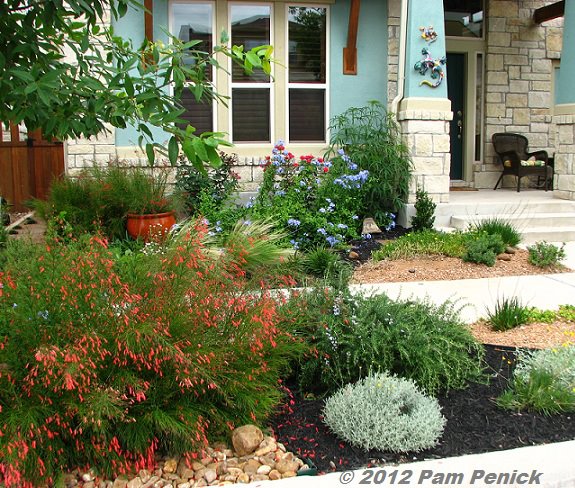Drive-By Gardens: Colorful front garden instead of lawn in Mueller neighborhood
If you’ve always thought bigger is better where a garden is concerned, think again. This week I spent a little time in East Austin’s Mueller neighborhood, a planned community (on the site of Austin’s old airport) built to encourage a sense of community with houses close to the street, small lots, and neighbor-friendly front porches. A client was showing me gardens he liked in the neighborhood, including this one near his house. Isn’t it delightful? I love the free use of color, the sense of movement thanks to curving decomposed-granite beds, and the low-maintenance, drought-tolerant nature of the tough plants the owner chose.
A lot of people in Mueller, with these postage-stamp lots, have planted gardens in place of lawn. Clearly, a tiny lot makes lawn removal a lot more do-able—and who could get any use out of such a small lawn anyway? Still, a surprising number of people are hanging onto their miniature mown lawns, and I can’t help wondering why, when a jewel-box garden like this offers so much more joy to the owner and neighbors alike.
I first posted these pictures on my Lawn Gone Facebook page (please “like” it if the topic interests you; I’m posting news about my upcoming book there too), where they got a big response. So I thought I’d share them here as well, providing inspiration, perhaps, for those of you with small lots and big garden dreams. Just look what you can do!
Also, check out a recent “Central Texas Gardener” episode about gardens at Mueller, including this one, and with interesting commentary about the community itself and the native-plant prairie that anchors the center of the development. I posted about Mueller’s prairie a couple of years ago and need to go back and see it again.
All material © 2006-2012 by Pam Penick for Digging. Unauthorized reproduction prohibited.





I think someone has done a very attractive job with the landscaping of those small gardens. My only concern would be the trees that have been planted. A perfect size now but they will change the dynamics of the gardens once they grow up. Creating more shade for sun loving plants would be one thing. I do hope the owners keep up with caring for their plants as they too grow up. For now those gardens are a delight to these drought weary eyes.
I completely agree with your tree assessment, Jenny. The entire neighborhood has these small front yards, with a double line of shade trees planted so that they will grow up and create a leafy tunnel over the street. It’ll be lovely, but the front yards will then be entirely in deep shade. In my client’s equally small front yard, he inherited two Chinquapin oaks, a live oak, and two crepe myrtles! I’m going to try to convince him to remove the live oak, as it’s planted right up against the house, plus it’s completely unnecessary given the two Chinquapins. —Pam
Between the trail and the front yards, Mueller has a ton of ideas for waterwise landscaping (the park benches under weeping desert willows in bloom is my fave). And this yard IS delightful, especially that firecracker fern! Maybe selling the lawn folks on the concept is all in the naming, because it’d be hard to resist ‘jewel-box garden’ if that were an option upon buying a home there.
That would be a great selling point, Amy. —Pam
Interesting topic…I think when the use of many trees is the prime objective, then the understory will have to be radically changed later. Eventual plant sizes, meeting codes and all the utilities in tight, infill construction, is not easy. Not sure who drives over-crowded trees elevated above the context of the whole landscape…gardens as designed by tree people, by code, by sun worshippers, etc. Your examples are colorful, and it would be interesting to see how their individual vs. development themes came about!
Trees take precedence here in Austin above all else, in both public spaces and private lots, at least in my experience. We pride ourselves on our green canopy—much-needed shade from the Death Star, you know. —Pam
Hey, Pam, thanks for pointing me to the Berkeley sedge photos. I cannot imagine how long it would take to establish this level of density. My plants have not grown at all in a year, nor have they spread babies like a mondo or liriope would. And now after seeing it, I ‘m definitely ripping it out. I don’t care for its growth habit. It looks like a large animal has camped on tall grass and mashed it down. Are we to believe this level of lushness came without a lot of water?
I don’t know, Libby. Berkeley sedge is rated as “low-water” by the City of Austin’s Grow Green Guide, but of course even the most drought-tolerant plants need plenty of water to get established. And last year was brutal, making it hard to establish anything. Or were you talking about the Mueller garden pictured in this post? —Pam
Would love to see a full plant list for this. I see plants that do well in Phoenix, so I know this has a lot of low water plants in it. Be interested in finding out about the ones I don’t recognize.
Here are the ones I can ID from the photos: Mexican feathergrass, wooly stemodia, Knock Out roses, firecracker fern, plumbago, red yucca, bulbine, blackfoot daisy, hymenoxys, and rosemary. —Pam
This is a fabulous garden. I love the idea of no lawn.
In a yard of this size, lawn seems a waste of space. —Pam
Nice…so much better than endless expanses of turf!
Yes, although in this case they wouldn’t have had an endless expanse. 😉 —Pam
I really love that area, especially the park and lake. I don’t know if I could handle a limited garden size but I’d like to try that someday. 🙂 Thanks for the CTG link – so lovely.
I think one day I could go this small, Jean. But not yet. 🙂 —Pam
That is so lovely. Love the spots where there is mulch only, a contrast of mulch and highs and lows in plants. Makes the garden visually appealing!
It is well designed, isn’t it? Quite pretty and interesting too. —Pam